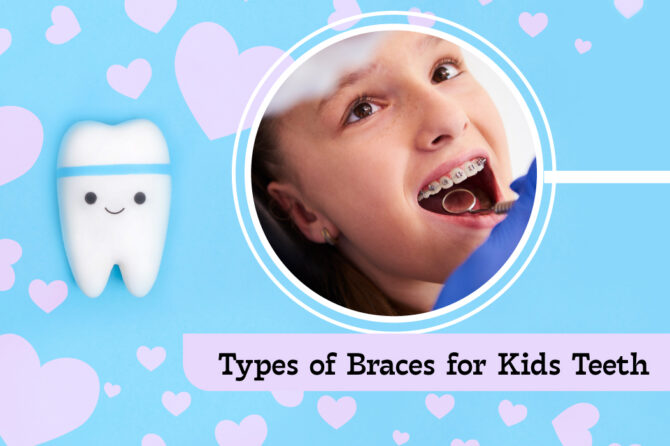
The Different Types of Braces for Kids Teeth
Orthodontic treatment can be an important investment in your child’s oral health, helping to correct alignment issues and improve the appearance and function of their teeth. One of the most common forms of orthodontic treatment for kids is braces. However, there are many different types of braces to choose from, each with its own advantages and disadvantages.
In this blog, we will explore the different types of braces for kids’ teeth, including traditional metal braces, ceramic braces, lingual braces, and clear aligners. We will discuss how each type of braces works, who they are best suited for, and what to expect during the dental treatment process. Whether you are a parent or caregiver, understanding the different options for braces can help you make informed decisions about your child’s orthodontic care.
What are braces?
Braces are orthodontic appliances that are used to correct alignment issues and improve the appearance and function of the teeth. They are most used in children and teenagers, although adults can also benefit from orthodontic treatment with braces. Braces consist of brackets, wires, and bands that are attached to the teeth and adjusted over time to gradually shift the teeth into their proper position.
The brackets are attached to the front of the teeth using a special adhesive, and the wires are threaded through the brackets and adjusted periodically to apply gentle pressure to the teeth. The bands are placed around the back molars to anchor the wires in place. Braces can be used to correct a wide range of orthodontic issues, including crooked teeth, crowded teeth, gaps between teeth, overbites, underbites, and crossbites.
While traditional metal braces are still the most common type of braces used, there are now several different options for braces that offer varying levels of visibility and comfort. The type of braces that is best suited for your child will depend on their individual orthodontic needs and personal preferences.
Is it suitable for kids to have teeth braces?
Yes, it is suitable for kids to have braces. In fact, orthodontic treatment with braces is most done in children and teenagers, when their teeth and jaw are still growing and developing. By starting orthodontic treatment at a younger age, it is often possible to correct alignment issues more easily and effectively than if treatment is delayed until adulthood.
The American Association of Orthodontists recommends that children have their first orthodontic evaluation by the age of 7, as this is the age when many orthodontic problems can be detected and treated early. However, the actual age at which your child may need braces will depend on their individual orthodontic needs.
While traditional metal braces are still the most common type of braces used in children, there are now several other options for braces that can offer greater comfort and aesthetics. Your orthodontist can help you determine which type of braces is best suited for your child’s needs and preferences.
Overall, orthodontic treatment with braces can offer many benefits for kids, including improved oral health, better function and appearance of the teeth, and increased self-confidence. It is important to discuss your child’s orthodontic needs with a qualified orthodontist to determine the best course of treatment for them.
Advantages of braces for kids
There are many advantages of braces for kids, including:
- Improved oral health: Braces can help correct alignment issues that make it difficult to clean the teeth properly, reducing the risk of tooth decay, gum disease, and other oral health problems.
- Better function of the teeth: By correcting alignment issues, braces can help improve the way the teeth work together, making it easier to eat and speak.
- Enhanced appearance: Braces can straighten crooked teeth, close gaps, and correct bite issues, resulting in a more attractive and confident smile.
- Increased self-confidence: Many children feel self-conscious about their teeth when they are misaligned or have bite issues. By improving their smile, braces can help boost their self-esteem and confidence.
- Prevent future problems: By correcting alignment issues early on, braces can help prevent more serious dental problems from developing in the future.
- Customized treatment: Braces can be tailored to the individual needs of each child, ensuring that they receive personalized treatment for the best results.
- Long-lasting results: With proper care, the results of orthodontic treatment with braces can last a lifetime, providing a lifetime of benefits for your child’s oral health and overall well-being.
Overall, braces can offer many advantages for kids, improving their oral health, function, appearance, and self-confidence. If you are considering braces for your child, it is important to discuss your options with a qualified orthodontist to determine the best course of treatment for their individual needs.
The Different Types of Braces for Kids Teeth
There are several types of braces available for children, each with their own benefits and drawbacks. Here are some of the most common types of braces for kids:
Traditional Metal Braces
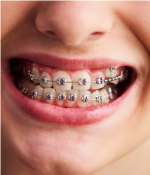 These are the most common type of braces, consisting of metal brackets and wires that are attached to the teeth. They are effective at correcting a wide range of dental problems, and are generally the most affordable option.
These are the most common type of braces, consisting of metal brackets and wires that are attached to the teeth. They are effective at correcting a wide range of dental problems, and are generally the most affordable option.
Ceramic Braces
 These braces are similar to traditional metal braces, but the brackets are made from clear or tooth-colored ceramic material that blends in with the teeth. They are less noticeable than metal braces, but can be more expensive and require more maintenance.
These braces are similar to traditional metal braces, but the brackets are made from clear or tooth-colored ceramic material that blends in with the teeth. They are less noticeable than metal braces, but can be more expensive and require more maintenance.
Lingual Braces
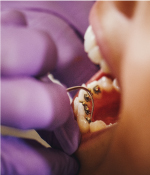 Lingual braces are similar to traditional metal braces, but they are attached to the back of the teeth instead of the front, making them virtually invisible from the outside. They can be more difficult to clean and adjust, and may cause some discomfort to the tongue.
Lingual braces are similar to traditional metal braces, but they are attached to the back of the teeth instead of the front, making them virtually invisible from the outside. They can be more difficult to clean and adjust, and may cause some discomfort to the tongue.
Self-Ligating Braces
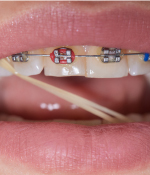 These braces use a special clip instead of elastic bands to hold the wire in place, which can reduce friction and discomfort. They are also easier to clean than traditional braces.
These braces use a special clip instead of elastic bands to hold the wire in place, which can reduce friction and discomfort. They are also easier to clean than traditional braces.
Clear Aligners
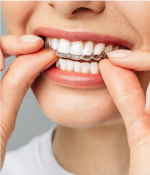 Clear aligners, such as Invisalign, are a series of clear, removable trays that gradually shift the teeth into their correct position. They are virtually invisible and can be removed for eating and brushing, but may not be suitable for more complex dental issues.
Clear aligners, such as Invisalign, are a series of clear, removable trays that gradually shift the teeth into their correct position. They are virtually invisible and can be removed for eating and brushing, but may not be suitable for more complex dental issues.
It’s important to consult with an orthodontist to determine which type of braces is best for your child’s specific needs and lifestyle.
Conclusion
In conclusion, there are several different types of braces available for kids, each with its own unique advantages and disadvantages. Traditional metal braces are still the most common type of braces used in children, but newer options like ceramic braces, lingual braces, and clear aligners offer greater comfort and aesthetics. The best type of braces for your child will depend on their individual orthodontic needs and personal preferences. Regardless of the type of braces used, orthodontic treatment can offer many benefits for kids, including improved oral health, better function and appearance of the teeth, and increased self-confidence. If you are considering braces for your child, it is important to discuss your options with Kid’s Dental Studio to determine the best course of treatment for their individual needs.
Leave a reply